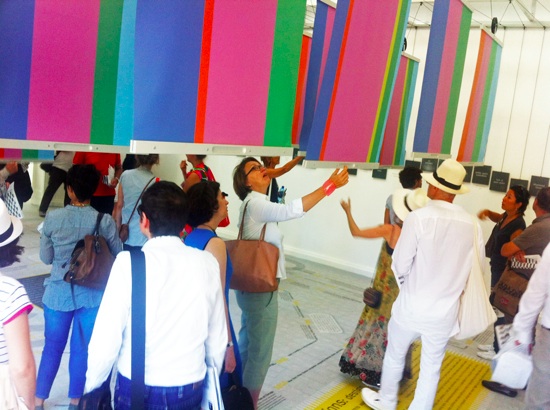by: Genevieve Brannigan

Exterior, U.S. Pavilion
Courtesy Interboro

Interior, U.S. Pavilion
Courtesy M-A-D

Interior, Japanese Pavilion
Courtesy Naoya Hatakeyama
Event: 13th International Architecture Exhibition, directed by David Chipperfield, on view through 11.25.12
Location: Venice, Italy
The eyes of the architecture world have turned to Venice with the commencement of the 13th Biennale of Architecture. Directed by British architect David Chipperfield, the Biennale has become the largest and most significant international event on the architecture calendar with more than 34 countries and numerous practices and individuals exhibiting, collaborating, and participating. Through the theme “Common Ground,” the role of architecture and its relationship with society is examined, signifying an increased focus on dialogue between architects, designers, and the public.
The United States pavilion explores the growing global movement of “urban interventions” – actions undertaken by individuals in collaboration with communities that result in positive change. Entitled “Spontaneous Interventions: design actions for the common good,” the pavilion features 124 completed urban interventions initiated by architects, designers, planners, artists, and everyday people. Cathy Lang Ho in collaboration with Ned Cramer and David van der Leer, for the Institute for Urban Design, organized the exhibit, along with Anne Guiney, the Institute’s executive director, and Michael Sorkin, its chairman. The pavilion won a Special Mention award – the first award for any U.S. pavilion exhibition since the Architectural Biennale was first launched in 1980.
Showcased through a series of interactive banners, interventions featured in the pavilion included outdoor living rooms, “parklets,” portable playgrounds, and guerrilla bike lanes. These actions collectively demonstrate a move away from traditional top-down urban improvement, toward individuals taking control to improve their own common ground.
The pavilion also features a timeline that maps out other significant urban intervention projects in U.S. history, along with a video installation showing a selection of urban-interventionists presenting the case for their actions as if they were running for office, referencing the political atmosphere of the current election year.
The Japanese pavilion exhibit, “Possible here? – Home-for-all,” also focuses on community, drawing inspiration from last year’s tragic tsunami and earthquake. Architect and pavilion commissioner Toyo Ito worked with Atsuko Sato and Tae Mori to explore architecture in its most primeval form – why buildings are really made and how they relate to the people who occupy them.
To create the exhibit, Ito conducted extensive interviews with people affected by the disaster and accommodated by the temporary housing projects that ensued. The past and future of the city of Rikuzentakata is studied through a series of small-interconnected building models, against a photographic backdrop shot by Naoya Hatakeyama – a local who lost his mother in the disaster. Exploring future directions architecture in the region may take, while offering insight into the psyche of the Japanese people and the process of engagement with the community during the rebuilding process, the pavilion was awarded the Golden Lion for Best National Participation.
Russia further explores the notion of community with its pavilion, curated by Sergei Tchoban and Sergey Kuznetsov. Inside the striking two-level space, visitors become both scientist and explorer to uncover the communities of Russia’s past and future in a highly interactive, two-part experience entitled “i-city” and “i-land.” On the lower level, visitors are enticed to spy through peek holes at secret cities developed by the Soviet Union for scientific research. On the upper level, an optimistic vision for a new Russian city dedicated to science is offered via a mosaic of interactive QR codes, decoded and viewed via hand held tablets. This futuristic environment invites users to interact with and dissect information, while showcasing Russia’s technological and architectural advancements in urban design. The Russian pavilion was also given a Special Mention in the Golden Lion awards; a full list of winners is here.
Genevieve Brannigan is the Principal of Communications Collective, a specialist communications and PR practice for the architecture sector.











